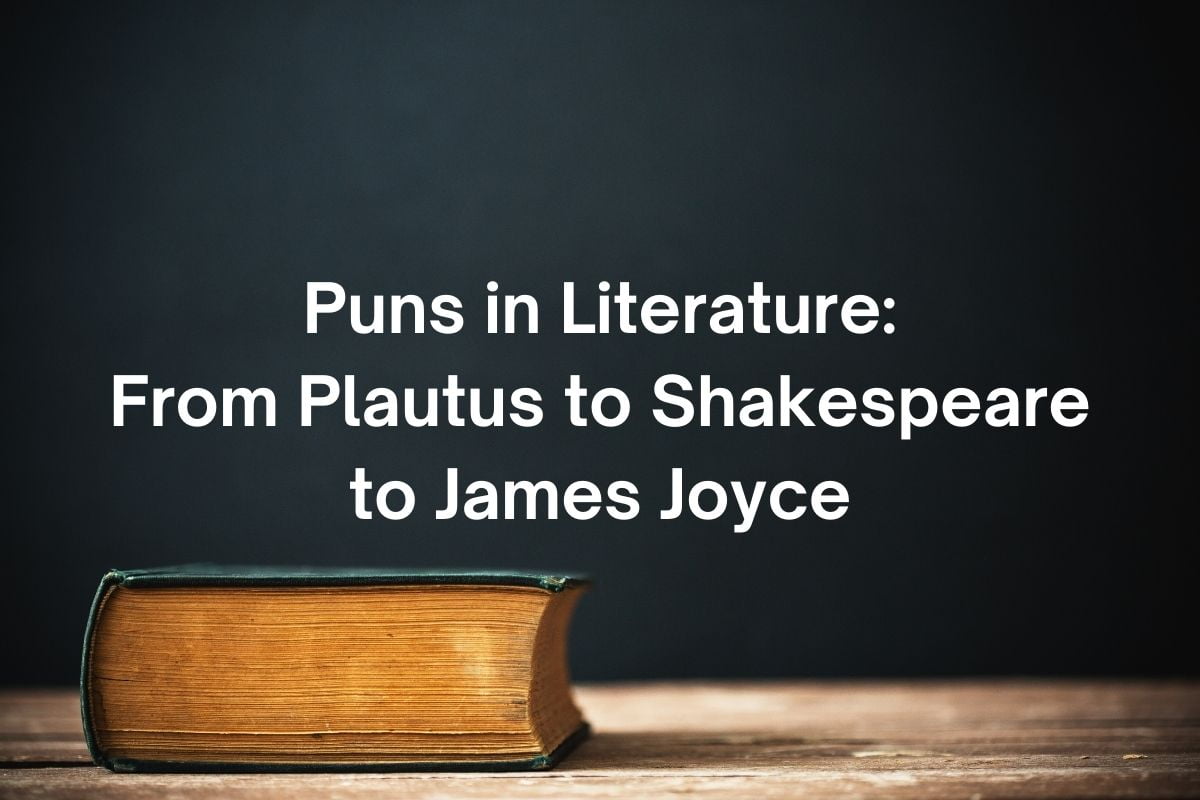Puns in Literature: From Plautus to Shakespeare to James Joyce

Puns aren’t just for dad jokes and cheesy pick-up lines, they have graced the pages of some of the most celebrated works.
From the works of William Shakespeare to contemporary novels, puns have played a significant role in shaping the way we read and interpret texts.
This blog post discusses the world of puns in literature while exploring their origins, various types, and the reasons why authors use them. So, let’s begin…
The Origins of Puns in Literature
The use of puns in literature can be traced back to ancient times. Early examples of wordplay can be found in the writings of classical Greek and Roman authors.
For instance, the Greek playwright Aristophanes often used puns to add humor to his comedies.
Similarly, Roman poets like Ovid and Plautus incorporated puns into their works to engage their audiences and enhance their storytelling.
However, it was during the Renaissance period that puns truly flourished in literature.
This era, marked by a renewed interest in classical learning and the arts, saw the emergence of some of the greatest playwrights and poets in history.
Among them, William Shakespeare stands out as a master of the pun. Shakespeare’s plays are replete with clever wordplay, demonstrating his profound understanding of the English language and its nuances.
Check Out: History of Puns from 4,000 BCE to The Middle Ages & 21st Century
4 Types of Puns in Literature
Puns come in various forms, each with its unique charm and function in literature. Understanding these types can help us appreciate the skill and creativity involved in crafting them.
Homophonic puns rely on words that sound alike but have different meanings. Shakespeare frequently used homophonic puns in his plays.
For example, in “Romeo and Juliet,” Mercutio says, “Ask for me tomorrow, and you shall find me a grave man.” Here, “grave” means both serious and a burial place, highlighting the duality of Mercutio’s fate.
Homographic puns, also known as homonymic puns, involve words that are spelled the same but have different meanings.
An example can be found in Lewis Carroll’s “Through the Looking-Glass,” where the character of the White Knight says, “It’s my own invention.”
The pun here lies in the word “invention,” which can mean both a creation and a fabricated story, reflecting the whimsical nature of Carroll’s writing.
Compound puns are more complex, involving multiple layers of wordplay within a single phrase or sentence.
These puns require a deeper understanding of language and often combine homophonic and homographic elements.
An example of a compound pun can be seen in James Joyce’s “Ulysses,” where the character Stephen Dedalus says, “History is a nightmare from which I am trying to awake.”
The pun lies in the word “awake,” which can mean both waking up and being alert to the horrors of history.
Lastly, visual puns rely on images or graphics to convey the pun.
While these are more common in visual media like cartoons and advertisements, they can also be found in illustrated literature.
For instance, the children’s book “The Stinky Cheese Man and Other Fairly Stupid Tales” by Jon Scieszka and Lane Smith uses visual puns to add humor and engage young readers.
Why Authors Use Puns
Authors use puns for various reasons, each serving a distinct purpose in their writing. Here are some key motivations behind the use of puns in literature:
Humor
One of the most obvious reasons authors use puns is to inject humor into their works. Puns can lighten the tone of a story, making it more enjoyable for readers.
In comedic plays and novels, puns are often used to elicit laughter and entertain the audience.
For instance, Oscar Wilde’s play “The Importance of Being Earnest” is filled with puns that add to its witty and satirical nature.
Characterization
Puns can also be used to develop characters and reveal their personalities. A character who frequently uses puns may be portrayed as witty, clever, or playful.
Conversely, a character who struggles to understand puns might be depicted as more serious or literal-minded.
Shakespeare’s character Mercutio in “Romeo and Juliet” is a prime example of how puns can be intentionally made to be used for characterization, showcasing his quick wit and humorous disposition.
Wordplay and Linguistic Skill
Puns allow authors to showcase their linguistic skill and creativity. Crafting a good pun requires a deep understanding of language and its nuances.
By incorporating puns into their writing, authors can demonstrate their command over words and engage readers who appreciate clever wordplay.
James Joyce’s “Finnegans Wake” is renowned for its complex and multifaceted puns, challenging readers to unravel its intricate layers of meaning.
Double Meanings and Ambiguity
Puns can add depth and complexity to a text by introducing double meanings and ambiguity.
This can enrich the reader’s experience, inviting them to explore multiple interpretations of a passage. In poetry, puns can enhance the thematic resonance of a poem by layering additional meanings onto its words.
For example, John Donne’s poem “A Hymn to God the Father” uses puns to explore themes of sin and redemption.
Engaging the Reader
Puns can engage readers by encouraging them to think critically about the text.
A well-placed pun can prompt readers to pause and consider the multiple layers of meaning within a sentence.
This interactive element can make reading more engaging and rewarding. In children’s literature, puns are often used to captivate young readers and stimulate their interest in language.
The Impact of Puns on Readers
Puns have a profound impact on readers, enhancing their engagement with the text and enriching their reading experience.
Here are some ways in which puns affect readers:
Enhancing Enjoyment
Puns add an element of fun and playfulness to literature, making reading a more enjoyable experience.
The humor and wit of puns can evoke laughter and amusement, creating a positive emotional response.
For readers who appreciate wordplay, encountering a clever pun can be a delightful and memorable moment.
Encouraging Active Reading
Puns encourage active reading by prompting readers to think critically about the text. Deciphering a pun requires attention to detail and an understanding of language nuances.
This active engagement can deepen readers’ connection to the text and enhance their comprehension of its themes and meanings.
Fostering Appreciation for Language
Puns highlight the beauty and versatility of language, fostering an appreciation for its richness and complexity.
They demonstrate how words can be manipulated to convey multiple meanings and create intricate layers of interpretation.
For readers who love language, puns are a testament to the creativity and ingenuity of authors.
Creating Deeper Connections
Puns can create deeper connections between readers and characters by revealing insights into their personalities and emotions.
A character’s use of puns can make them more relatable and endearing, adding depth to their portrayal.
For example, Shakespeare’s use of puns in Hamlet’s soliloquies reveals his introspective and melancholic nature, drawing readers into his inner world.






